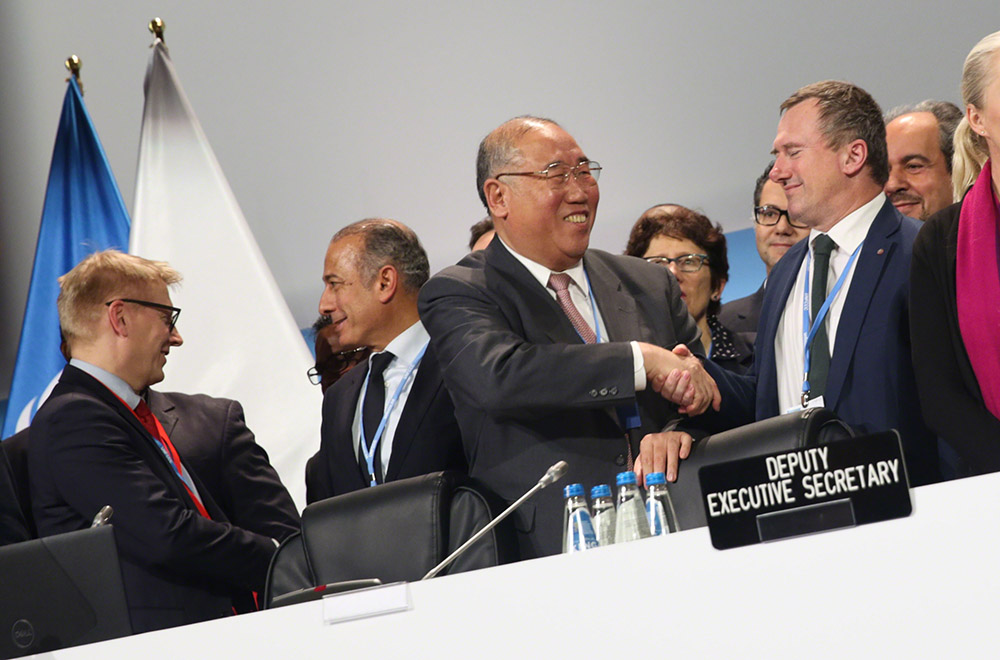Tibetans made a big effort to be a presence during the complex global negotiations that in 2015 produced the Paris climate change agreement.In 2015 and in earlier years Tibetans closely tracked the frustratingly slow back and forth of a world grappling with looming climate catastrophe, but unwilling to actually do much about it. The outcome in Paris did not match worldwide hopes. In order to get a treaty at all, it has been left up to each country to nominate for itself what contribution it will make, and there were very few rules on how those contributions would be measured or verified, how governments would be held accountable. Even worse, there were plenty of perverse incentives enabling selfish governments to claim credit for doing nothing, especially if past estimates of their emissions had proven inaccurate.
For Tibetans, one striking result of the Paris agreement was that China did not even pledge to reduce emissions by any definite amount at all, only by China’s unique metric, which is carbon emissions per unit of GDP output. That is energy efficiency, not emissions reduction. The most China was willing to promise was that actual emissions would start to reduce by 2030, and with luck, a bit earlier. The scientists say that’s too late.

Not only Tibetans found this frustrating, because a promise of less emissions per renminbi of output is incommensurate with those countries that did pledge actual emissions reductions. How to compare?
So the 2018 UN Framework Convention on Climate Change Conference of Parties, amid the coal fired smoke stacks of Katowice, Poland, was meant to at the very least iron out the rulebook, and ensure no country cheats, or claims credit for doing nothing.
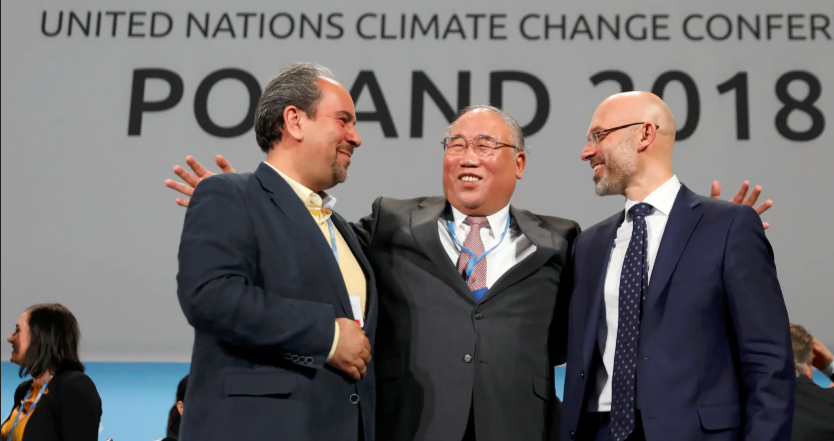
The Katowice COP24, which Tibetans prudently did not attend,achieved very little. The headlines suggested success, but when you look at the fine print, clearly no-one has heard of the Dalai Lama’s idea of universal responsibility, thinking and acting for the planet. Instead each country was out to maximise its advantages and surrender as little as possible to the universal need for effective action.

During the two weeks the Katowice talks bogged down in technical detail, this generated a familiar dualistic narrative, of baddies and goodies.The baddies, denying climate change as a reality, seeking to water down collective action, even brazenly championing coal, were easy to pick. The United States made the most of having announced it was pulling out altogether, yet until 2020 remains in the UNFCCC simply because the rules require three years advance notice of withdrawal. Far from being a lame duck on the way out, the US delegation threw its weight around, demanding inaction and denial. There were plenty of other baddies, the usual suspects. Big oil producers Russia, Saudi Arabia, Kuwait joined the US in downplaying the latest scientific report that says if we cannot reduce actual emissions by 45% by 2030; the planet will heat faster and faster, uncontrollably, meaning big trouble for us all. Brazil became another baddie, seeking to have its remaining forests counted doubly as removers of atmospheric carbon.
But a dualistic narrative demands a goodie. Who was wearing the white hat? Many observers nominated China as the new leader of responsible environmental action, even as an exemplary builder of “ecological civilisation.”So we ought to look closely at the role China played at the Katowice COP24,with a focus on those aspects of the UNFCCC that impact most on Tibet.
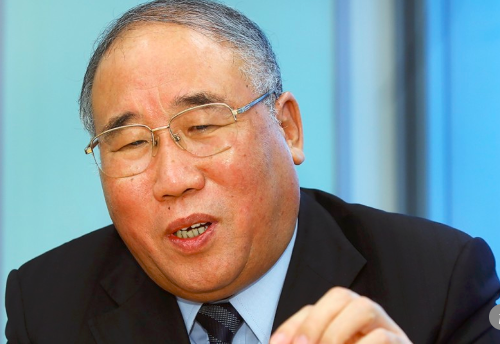
Did China nominate actual emissions reductions, and when they would be achieved? No.
Did China agree to uniform rules applicable to all carbon emitting countries, whether developed or developing? Sort of, with lots of exceptions.
Did China seek payment by rich countries to adapt its technologies to be more efficient in carbon use? Yes.
Did China pledge to crack down on factories producing especially harmful climate warming gases that are far more damaging than carbon dioxide? Did China acknowledge that those gases, as they drift up into the upper atmosphere, collect over Tibet, creating an ozone hole that has failed to reduce? No.
Did China allow international inspection of its climate change efforts? No.
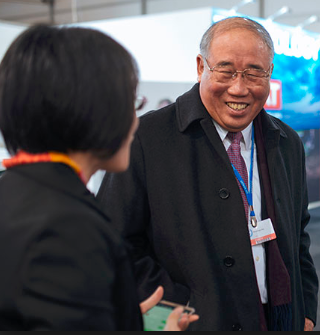
So what did China actually do during the scheduled 14 days of the COP24, plus the extra two days tacked on when 14 days resulted in stalemate?
China’s script has long been to position itself as the leader, mentor, role model and exemplar for the entire developing world, in order to be exempt from the same requirements imposed on the rich countries.China as champion of the developing countries is increasingly a stretch, and in Katowice, many small developing countries, especially the small island states starting to disappear under the waves of expanding oceans, were especially unhappy about China as their designated leader. But China stuck to its script,its mantra being “differentiated responsibilities.” That vague diplomatic phrase means the rich countries, historically the earliest emitters, are held to higher standards than other countries. In terms of climate justice, that makes sense, but if it means China is not obliged to do anything much, despite being the world’s biggest emitter, that’s hardly planetary progress. Hence the unease among many smaller countries.
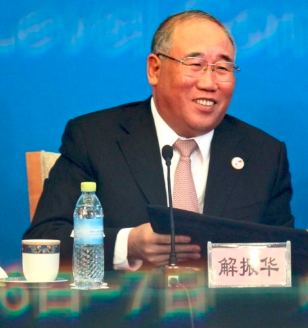
Under the banner of differentiated responsibilities, China has held out even on basic rules on how emissions are calculated, so data worldwide is comparable. Eventually, China did reluctantly agree to uniform standards for measuring emissions, but even then China’s jovial but inflexible chief negotiator Xie Zhenhua insisted on lots of wriggle room: “Developing countries also have varied levels of capabilities. Some might need greater flexibilities, while others could voluntarily do more and accept uniform standards. With more support given to them and enhanced capabilities for these developing countries, they will be able to meet their requirements earlier and faster.”
That was the headline good news story of the Katowice COP24,as good as it gets. All the other obstacles to a concerted global effort to get serious about climate change have now been put off to a COP, in 2020, probably in London.
This will greatly disappoint those who hoped for a sense of urgency, and effective action. Momentum has been building, throughout 2018,with one report after another making it clear what needs to be done, and how quickly, before the heating of the planet takes on irreversibly accelerating momentum of its own.

Little wonder Xie Zhenhua has a wide grin. He is a member of the CCP Central Committee, an engineer and physicist by training, from the Tianjin-Beijing megapolis. He is vice minister of the central planners, the National Development Reform Commission. His career suffered a setback in 2005 when a toxic spill in Tianjin, his home turf, badly polluted the river, and someone had to take the rap. But by 2009 he was back, leading China’s delegation in Copenhagen, and in 2015 in Paris, a long career of privileging China’s exceptional status over all comers, big and small. For small island states sinking under rising oceans who needs friends like that?
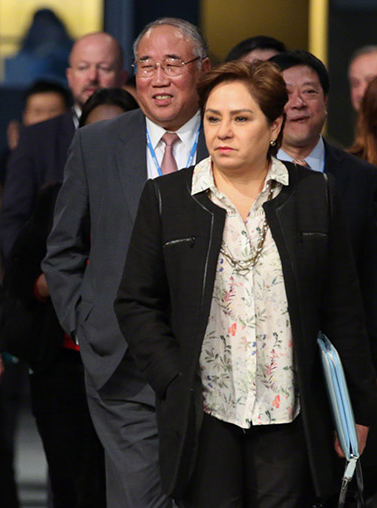
Now 2020 is shaping up as a crucial year. Not only will it be a year of climate change debate, it is also when everyone who cares for animals, and hopes to preserve shrinking biodiversity, gets together for the Conference of the Parties to another key UN environmental treaty, the Convention on Biodiversity (CBD), due to be held in Beijing towards the end of 2020.
China is energetically preparing itself for the CBD COP, which will be setting targets for the decade that follows, painfully aware that the targets for 2010 to 2020 largely failed to materialise. One of the many targets the CBD set for itself in 2010 was that every sovereign state should set aside 17% of its total space for biodiversity conservation.
That is what prompts China to make preparation now to launch in 2020 its system of national parks, four of the ten to be in Tibet, by far the biggest by area. Thanks to Tibet’s official designation as Key Ecological Function Zone area, China will meet that target of 17% set aside for conservation,so who will notice if that means most remaining drogpa nomads, in the name of biodiversity, are moved out of national parks which are actually prime pasture lands of Kham and Amdo?
So 2020 is now the focus, the year of the next climate and biodiversity COPs, and of China’s launch of four national parks across the Tibetan Plateau. China covets its special status as champion of the developing world, champion of ecological civilisation and biodiversity conservation, and Tibet provides the means.
Other issues discussed endlessly at Katowice but without result also affect Tibet. China is keen to adopt “market mechanisms” enabling polluters worldwide to buy carbon capture in Tibet, through carbon trading.This means turning the pastures of Tibet into monetisable “natural capital”that has a renminbi agreed valuation, making the lands of Tibet tradable commodities. Those lands rise in value if no grazing animals any longer range across the grassland, so more grass grows, and more carbon is captured, though nothing like the carbon capture on a bigger scale in growing forests. What makes Tibet a globally marketable commodity is the absence of herds and herders.
At Katowice there was much focus on those market mechanisms,since they don’t actually require emitters to reduce emissions, or guarantee on a global scale any actual cut in emissions.“One final issue under discussion within Article 6 was ‘overall mitigation in global emissions’ (OMGE). This language was introduced by the Paris Agreement to explain the idea that carbon trading should generate a net benefit for the climate, rather than being a zero-sum game. Early drafts included options that would have automatically cancelled up to 30% of all offsets generated. Analysts, climate vulnerable countries and many NGOs said automatic cancellation was necessary to ensure OMGE. However, later versions of the draft text made cancellation voluntary.”
In all, Tibetan concerns did not fare well, and Tibet is now fast being globalised, with national parks put forward as China’s construction of ecological civilisation, for which Chinese officials expect to be paid by investors and polluters, in the market to buy carbon trading credits that let them continue polluting. Is this progress, for Tibet, for the world?
